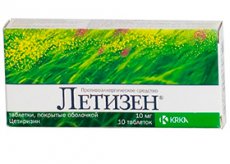Medical expert of the article
New publications
Preparations
Letizen
Last reviewed: 23.04.2024

All iLive content is medically reviewed or fact checked to ensure as much factual accuracy as possible.
We have strict sourcing guidelines and only link to reputable media sites, academic research institutions and, whenever possible, medically peer reviewed studies. Note that the numbers in parentheses ([1], [2], etc.) are clickable links to these studies.
If you feel that any of our content is inaccurate, out-of-date, or otherwise questionable, please select it and press Ctrl + Enter.

Letizen helps to get rid of allergic symptoms, as well as itching; In addition, the drug has an antiexudative effect.
The active component of a therapeutic agent, cetirizine, helps to strengthen the strength of blood vessels, thereby eliminating smooth muscle spasms and preventing the appearance of puffiness. The use of medication in people with mild forms of asthma helps to weaken histamine-associated bronchoconstriction.

Indications Letizena
It is used as a means of therapy for persistent or seasonal conjunctivitis or runny nose, arising from the influence of allergens.
It is also prescribed in the case of urticaria, angioedema, pollinosis, and itchy dermatoses (allergic origin).
Release form
The release of the drug product is implemented in tablets and oral solution.
Tablets have a volume of 10 mg and contain 10 pieces inside the cell packaging. In the box 1 or 2 of these packaging.
The solution is contained in vials with a capacity of 0.12 liters. Inside the pack - 1 bottle with a solution and a dosing syringe.

Pharmacodynamics
The antihistamine effect of the drug develops when blocking the activity of the peripheral endings of histamine H1 under the action of cetirizine. The drug is most effective in the early stages of allergy; it weakens the release of the mediators of the later stages of the allergic process.
The drug eliminates the epidermal symptoms that occur under the influence of cold allergies, specific substances, allergens, as well as in the case of the introduction of histamine.

Dosing and administration
The drug in both forms of release should be taken at the same time of the day (it is recommended to do it in the evening), drinking plain water. A portion of the solution is recruited through a dosing syringe, attached in a pack of medicine.
For a teenager over the age of 12 and an adult, 1 tablet (10 mg volume) is required, which is taken 1 time per day. A child of 6-12 years old is prescribed 0.5 tablets (5 mg), 1 time per day.
A solution to a teenager from 12 years old and an adult is prescribed in a portion of 10 mg 1 time per day (corresponding to 10 ml - to the 2nd dosing syringes). Infants 1-2 years old apply 2.5 ml of the substance 2-fold per day. At the same time, children of 2-6 years old - 5 ml of drugs 1 times a day (or 2.5 ml of liquid 2 times a day), and children of 6-12 years old - 5 ml of the substance 2 times a day day.
In case of mild disorders of the renal function, 5 mg of the drug is required to be taken 1 time per day; if the degree of violation is severe, 5 mg of the drug should be administered 1 time in 48 hours.
The duration of the treatment cycle is determined by the severity of the allergic disorder and is chosen personally by the attending doctor.
Contraindications
The main contraindications:
- the presence of intolerance associated with elements of a therapeutic agent;
- gylactasia;
- terminal phase of renal failure;
- fructose or lactose intolerance.
Caution is needed when treating patients with chronic kidney disease, hepatic abnormalities, as well as when prescribing for elderly people.

Side effects Letizena
Often, the use of drugs causes a runny nose, dry oral mucous membranes, pharyngitis, headaches, and in addition, systemic weakness, nausea, dizziness and thrombocytopenia.
Occasionally, Letizen’s administration leads to drowsiness, agitation, migraine, insomnia, and confusion. In addition, there are disorders of taste, pain in the abdomen, paresthesias and problems with hepatic function. Tremor, tachycardia, convulsions, syncope, hallucinations, aggressiveness, dyskinesia, dystonia, confusion and nystagmus also occur. There is an increase in weight, tick, enuresis, asthenia, impaired urination, visual or accommodative disorder, and in addition to this swelling in the legs.
Taking the medication can cause allergy symptoms (rash, angioedema, pruritus, anaphylaxis and urticaria).

Overdose
In case of Letizen poisoning, there is inhibition, stupor, dizziness, anxiety and confusion, and in addition tachycardia, diarrhea, mydriasis, headaches, tremor, general malaise, confusion and urinary retention.

Interactions with other drugs
Metabolism and excretion of drugs are slowed by using theophylline.
When a combination of drugs and myelotoxic substances increases the risk of side signs of severe intensity.
 [6]
[6]
Storage conditions
Letizen should be maintained at a temperature not exceeding 30 ° C.
 [7]
[7]
Shelf life
Letizen can be applied for a period of 5 years from the date of sale of the pharmaceutical element.

Application for children
Drugs not prescribed in pediatrics until the 6th anniversary, and the solution - babies up to 12 months.
Analogs
Analogs of drugs are substances Rolinosis, Maxidex, Octylia and Hydrocortisone with Cortef and Clarisense. In addition, Solu-Medrol, Zaditen, Vizoptik and Medrol, Polynadim, Loragexal and Dephislosis are on the list, as well as Klarotadin, Prenacid, Zyrtec with Tsethirinx and Claridol.
 [10]
[10]
Attention!
To simplify the perception of information, this instruction for use of the drug "Letizen" translated and presented in a special form on the basis of the official instructions for medical use of the drug. Before use read the annotation that came directly to medicines.
Description provided for informational purposes and is not a guide to self-healing. The need for this drug, the purpose of the treatment regimen, methods and dose of the drug is determined solely by the attending physician. Self-medication is dangerous for your health.

